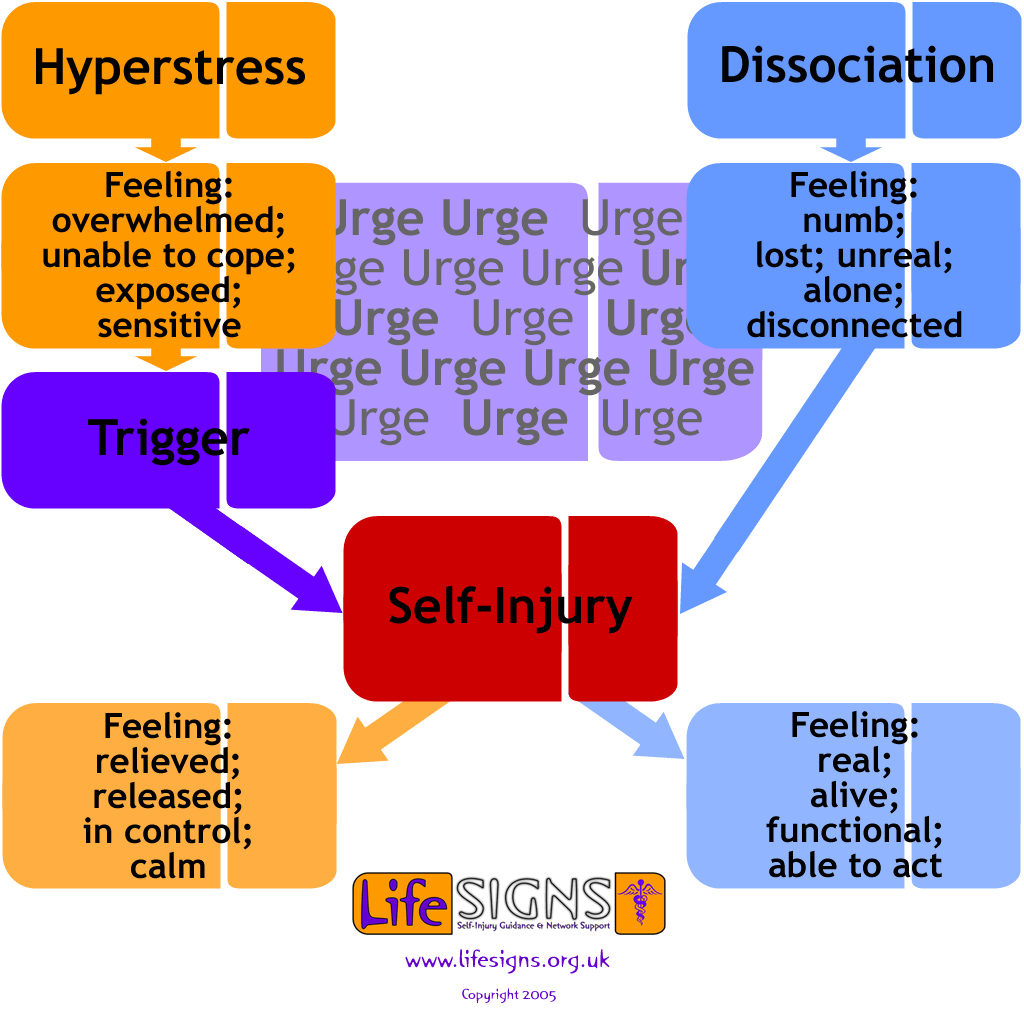This working theory attempts to describe the feelings and processes a person may go through before resorting to self-injury / self-harm.

LifeSIGNS considers self-injury to be a learnt behaviour in response to overwhelming feelings and distress; LifeSIGNS does not consider self-injury to be a physical addiction.
Hyperstress is thought to affect more people than dissociation in regard to self-injury.
Hyperstress
A person may be hyper-sensitive and overwhelmed; a great many thoughts may be revolving within their mind, becoming confused and entangled. They may be upset and tearful, or angry and destructive; they may well experience physical symptoms such as nausea or a racing heart, akin to panic†. They may either become triggered or could make a decision to stop the overwhelming feelings by resorting to self-injuring.
A trigger is an event that upsets and disturbs a person; it could be an internal event within the mind, or an external event that affects the person. Triggers can make a person feel a great deal worse and there is a feeling of panic and a need to directly, and immediately, end the distress.
When a person is already in a state of hyperstress the trigger that pushes them to self-injury, while possibly a distressing event in itself, may just as likely be something that could be considered small or trivial. This apparent drastic response to a trivial event can lead to others assuming a person is over-reacting or being dramatic. It must be understood that the trigger is often the ‘final’ thing that tips a person over the edge, and that the distress and urge to self-injure may have been building up over many hours, days or weeks.
Self-injury can have an immediate calming effect‡, slowing the mind down, calming the breathing and heart rate and enabling the person to cope, regain control and get on with things.
Dissociation
A person may be detached from life, detached from their emotions, from their body; numb and unfeeling. They may feel separate from ‘reality’, and may behave without conscious awareness. People who lose all sense of reality may be experiencing psychosis.
People suffering trauma or abuse may learn to dissociate themselves from what is happening. They may find that dissociation becomes an automatic response to stressful situations.
It’s possible that turning to self-injury when in a dissociated frame of mind does not require a trigger. A person may recognise the need to regain control, or have a desire to feel real again, and act so as to create a strong sensation and ‘wake up’.
Further experiences
Individuals may have other distressing experiences, including hearing voices, invading / unwanted and cyclical thoughts, paranoia, and more, that can add to their hyperstress or drive them to dissociate. Depression and low-self worth along with the learnt experience of gaining relief from strong physical sensation can lead to a reliance upon self-injury.
Self-injury is a coping mechanism. An individual harms their physical self to deal with emotional pain, or to break feelings of numbness by arousing sensation.
LifeSIGNS short definition of self-injury – www.lifesigns.org.uk
† Psychobiologists may wish to consider Adrenaline, Dopamine and Serotonin.
‡ Psychobiologists may wish to consider Noradrenaline, Dopamine, Serotonin and Endorphins.

4 Comments
You have received a email № 519. Open >>> https://forms.yandex.com/cloud/65a8ee19068ff028ad0eb570/?hs=8143bb12a3e4fa80afb00bfbf3387fca&
January 31, 2024r8r925
Margherita Grumi
January 4, 2019buon giorno, in quale modo è possibile distinguere se il trigger è l’iperstress o la dissociazione? ci sono test? può essere di aiuto l’ipnosi per riconoscere il fattore precursore?grazie
Wedge
January 7, 2019That would be too personal to theorise about.
Pablo Nas
February 11, 2017Me re ayudo con mi depresion este articulo. Capaz deje de culpar a mi equipo y juegue el match del domingo. Muchas gracias